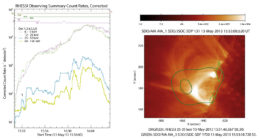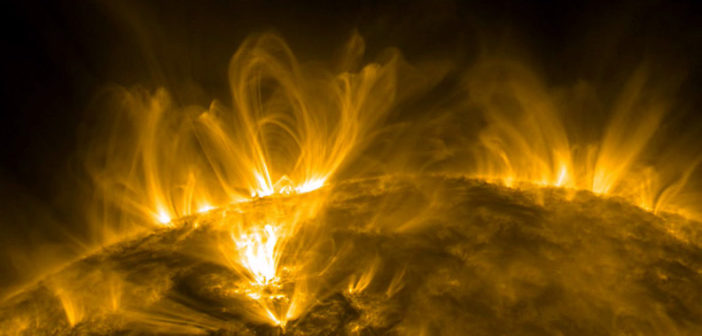Though solar flares are common — the Sun releases as many as 20 per day — these explosive events remain mysterious. What can models tell us about the uncertain origins of the X-rays we see at the onset of a solar flare?

Time evolution of flux in several energy bands (left) for the coronal loops shown on the right. Contour lines indicate the 25–35 keV flux. Click to enlarge. [Adapted from Shabalin et al. 2022]
A High-Energy Inquiry
In the early stages of a flare, solar plasma begins to glow in high-energy X-rays. These X-rays are associated with coronal loops — plasma suspended on arching magnetic field lines above an active region, where electrons in the hot, dense plasma travel at breakneck speed. Most of the X-rays arise from the base of these loops, where the density of the plasma is highest. However, observations show that X-rays can also arise from the top of the loop, high in the Sun’s tenuous upper atmosphere, or corona, where the density is far lower. What causes this emission?

Diagram of how magnetic field lines move in the collapsing trap model (left) and an example of how the magnetic field strength at the top of the loop varies with time as the field lines collapse (right). Click to enlarge. [Adapted from Shabalin et al. 2022]
It’s a (Collapsing) Trap!
Alexander Shabalin (Ioffe Institute) and collaborators approached this question by testing ways to generate X-ray emission in the rarefied environment of the solar corona, focusing on the collapsing trap model.
The “trap” in this model is a magnetic one: when magnetic field lines near the top of a coronal loop rearrange into a new configuration, the field lines lower down retract, snapping the “trap” shut and ensnaring any electrons that are present. The electrons bounce back and forth between the boundaries of this trap, and as the boundaries draw closer, the electrons’ velocities skyrocket. In theory, this process could concentrate and accelerate electrons enough for them to generate the X-ray emission we observe.
A Numerical Solution
Shabalin and coauthors numerically solved a system of equations that describe how the trapped electrons behave as the magnetic field in the coronal loop evolves. Their investigations focused on the effect of electrons traveling with different orientations relative to the field lines, and they explored how much these electrons were accelerated as individual strands of the coronal loop collapsed in sequence.

Percentage of the total 29–58 keV flux of the coronal loop that arises from the top of the loop as a function of time. The red dotted line shows the collapsing trap model results and the black solid lines shows a model in which the plasma density and magnetic field along the loop are constant with time. [Adapted from Shabalin et al. 2022]
The results show that the collapsing trap model is a viable explanation for the bright X-ray sources seen in the solar corona at the onset of a solar flare — and as the twenty-fifth solar cycle ramps up toward solar maximum in 2025, there should be plenty of solar flares to test these predictions!
Citation
“Early-stage Coronal Hard X-Ray Source in Solar Flares in the Collapsing Trap Model,” Alexander N. Shabalin et al 2022 ApJ 931 27. doi:10.3847/1538-4357/ac65fe

